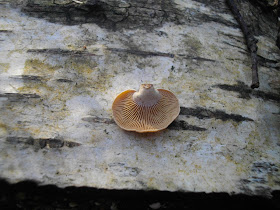31st October 2015
On Saturday I headed down to Whitlingham, but as it was a sunny day and rather busy, I decided to start off in the woods. As I entered the woods I noticed some Norway Maple saplings. I had previously not counted Norway Maple on my patch list as it would have been planted originally, but as it appears to be regenerating naturally, on it goes (958). The next thing I noticed was a caterpillar inside a leaf mine on a Hazel leaf. I photographed this, hoping that the pattern of the mine and the 'frass' (leaf miner poo!) would enable me to identify it at home. I was almost right - I got it down to two species of micro moth, but have been advised that I need to take a picture lighting up the mine more clearly to be sure which one it is.
Norway Maple
Mine in Hazel caused by a Phyllonorycter sp.
As it has been a wet week there were lots of snails about. Many of them were different patterned versions of the White-lipped Banded Snail, but I did find a new species for me, Hygromia cinctella, which I keyed out at home (959). Plaited Door Snail was another interesting snail, but one that I had seen in the woods several times before. There was a bit of fungi about, but not as much as there has been in the other places I've visited recently. One interesting species was the Fire-rug Inkcap, so called because the mycelium forms an orangey-brown furry mat, which is often visible on logs. Along the telegraph pole alley I photographed an adult Hawthorn Shieldbug, which I will add to my Shieldbugs species guide soon (currently there is only a late instar photo in it).
Hygromia cinctella
Plaited Door Snail
Fire-rug Inkcap - note the orangey 'fire rug'
Hawthorn Shieldbug
The next new species on my list was a Harvestman, Leiobunum rotundum (960). The males of this species are round and orangey, but they need to be looked at carefully to separate them from L. blackwalli. The key bit to look at is between the eyes, which is black on rotundum but white on blackwalli. In a hedgerow I saw the bright pink flowers seed cases of Wild Spindle. I wasn't sure whether this would have been planted or grown naturally, however I later saw it in a second location. The most recent Flora of Norfolk says that Spindle is "not infrequent on base rich soils", and given the chalky nature of Whitlingham Woods I reckon this is reasonable (961).
Leiobunum rotundum
Wild Spindle
Emerging from the woods I walked back as far as the island to scan for birds. A flock of Tufted Ducks flew east and most of the gulls had left the water and were circling around, making me suspect a Peregrine had just flown through, but I didn't see it. When the birds settled I picked out at least six Pochard and seven Great-crested Grebes, but not much else of note. I walked as far as the eastern end of the broad to scan over to Thorpe, but didn't see any of the Goldeneye that have been frequenting Thorpe Broad of late. On my way back I did noticed some very inconspicuous fungi, Slender Clubs, growing on some bark chippings (962). These could easily be mistaken for dead bits of leaf or shoots, and was a species that I hadn't seen for years, so were pleasing to see.
Slender Clubs
There was still time for a couple more interesting sightings. Firstly a brightly-coloured Comma butterfly was resting on some ivy. Probably the latest I've seen one flying, only a day off November. The second sighting was pure luck, I spotted a 'growth' on a tree branch and upon investigation it was a Vapourer moth cocoon, covered in eggs. Well camouflaged next to it I found the female moth. Female Vapourers are flightless, having only stubby vestigial wings. They emerge from their cocoon, attract a male by releasing pheromones and then lay their eggs on the cocoon they emerged from, often hardly moving at all as an adult! I think several other moths undergo a similar life cycle, but Vapourer is the most familiar one.
Female Vapourer moth and eggs


























































